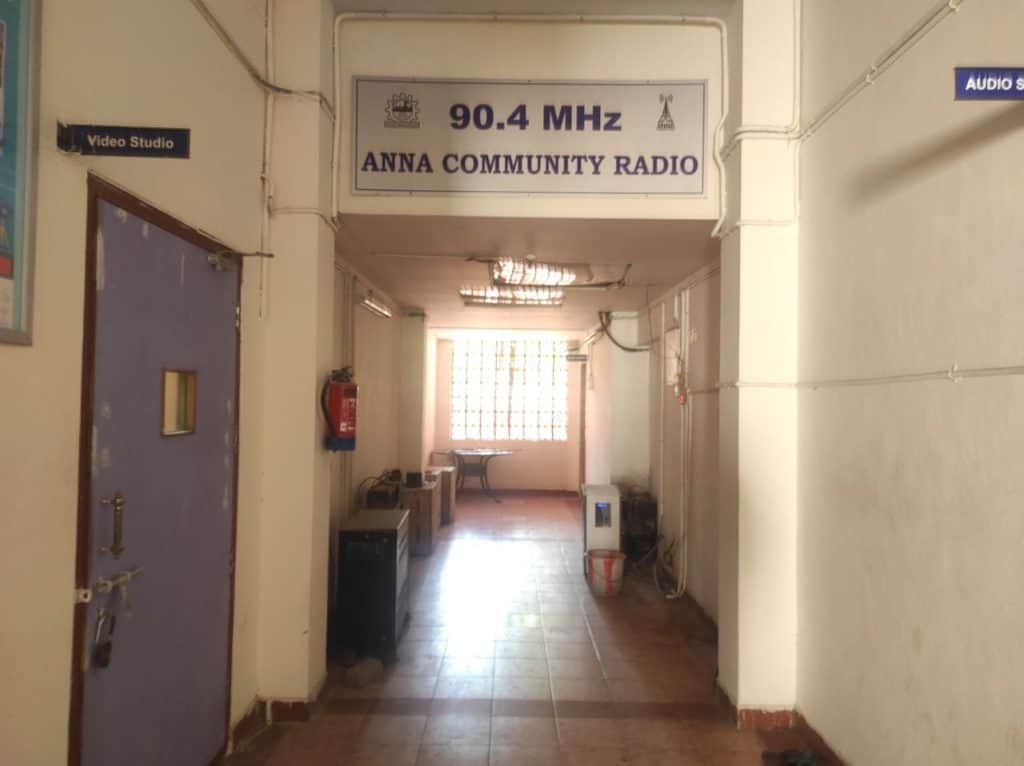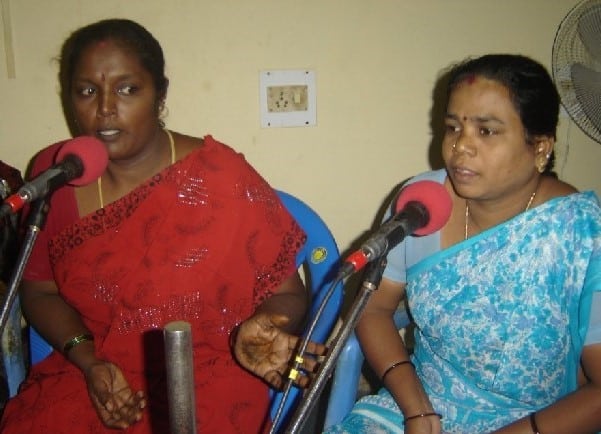“In 2013, a woman called Geetha came to our studio. She thanked us profusely for making her life peaceful as her husband had stopped drinking because of the work of Anna Community Radio,” recalls Malliga Kaliappan, who has been an RJ at Anna FM for 22 years. “Geetha’s husband had learnt about the ill-effects of alcohol consumption due to the anti-liquor awareness programmes we carried,” added the RJ.
Airing at 90.4 MHz, Anna FM is a social initiative taken up by the Educational and Multimedia Research Centre (EMRC) of Anna University since 2004. The community radio has touched the lives of many people, especially women from low-income communities. It was the brainchild of the then-head of the Media Sciences Department, Dr R. Sreedhar, who was also a stalwart of radio. Presently, Dr I Arul Aram is at the helm of the department and the FM.
Setting up and reach of Anna Community Radio
With a 50-watt transmitter and an antenna 30 metres high, Anna FM reaches areas within a 15-kilometre radius. During the setting up of the station, the digital studio cost around Rs 8 lakh and the antenna Rs 4.5 lakh, as reported in this study. The station began its first broadcast in February 2004. It serves as an example of collaboration between the community, students and staff.
“We reach around 4000 to 5000 people from the areas we cover,” says an administrative employee on the coverage of the station. The coverage locations include Mayilai Balajinagar, Venkatapuram, Nehru Nagar, Velachery Checkpost, Chitra Nagar, Kapali Thottam, Canal in Kotturpuram, and Vannandurai.
“We get a grant of Rs 5 lakh from the university to run the radio every year,” says Dr Arul. Apart from this grant, the Union Government pays them for airing advertisement campaigns around the year. Employees and students who work at the radio are paid using these funds. Moreover, they also provide honorariums to the presenters and anchors.
Anna Community Radio has been certified as one of the 24 Lead Community Radios by the Ministry of Information and Broadcasting, Government of India, valid until 2025. Currently, there are 364 community radio stations in India, with six stations in Chennai, including Anna FM. It also has the distinction of being India’s first campus community radio station.
Anna Community Radio checks all the boxes mandated by the government, including a 50% reservation for the community members in the managing committee of the station. Today, four community members and two university representatives form the managing committee, per the current head of the Department of Media Sciences.
Read more: Women achievers in Chennai we bet you haven’t heard of!
Involving and empowering the community
When community members join the radio, they are usually trained by the Media Sciences students before they conduct programmes independently, says Malliga, recounting her training period. “I was taught how to talk to audience and interview experts, how to avoid background noises, and many more techniques,” she elaborates.
“If not for Anna Community Radio, women like me would have never gone out of our neighbourhoods. I joined the radio station without the knowledge of my family in 2007. I used to enter and exit Anna University, afraid that someone will recognise me,” says S Selvakumari, an administrative employee from Velachery.
After three months, her family came on board, thanks to the Media Sciences students of Anna University. “They came to neighbourhoods like mine to convince families to encourage the women to get involved with the community radio,” she adds.
A few others did not face as many hurdles. “My family was happy, and encouraged me to work at Anna FM. However, I was sceptical about talking on the radio, initially. But when my husband appreciated me after hearing me on air, my confidence was restored,” shares Malliga.
“Nowadays, it is a matter of surprise if the community women do not come forth to be involved with the radio,” said Selvakumari, reflecting on changing times.
Radio presentation techniques are not the only skills these women grasp while working. “I have developed great self-confidence, apart from other basic skills that I can pass on to my family,” says Selvakumari.
For example, during an expert talk, a nutritionist spoke about how one should not pressure-cook greens as it will remove all the nutrients. Selvakumari says that she has unlearned the cooking method of greens, among other things.
Not just people who are on the production side of the radio, the listeners are also happy with Anna FM. “Many listeners give positive feedback via phone and e-mail,” says another administrative employee. When Citizen Matters contacted S Dhilip Kumar, a listener from West Mambalam, he said that every broadcast from the community radio contains information that is useful to everyone. He has been listening to Anna FM since 2012.
Read more: Six extraordinary women who are transforming Chennai
A peek into the programmes of Anna FM
“Initially, it used to be four hours of programming back then. Today, our radio runs for 12 hours, from 9 am to 9 pm,” explains Dr Arul. The programmes are usually in Tamil so that they can cater to the local communities. However, instructional and educational programmes for school children are in English.
“There are no film-based programmes, including the playing of songs on our FM,” confirms Surendran, an employee, adding that they would have to pay extra to get the license to play film songs.
Some of the key areas of focus for the programmes include women empowerment, social issues, health, environment, science awareness and education and personality development.
“I usually do programmes on women empowerment and education. For instance, I suggest how parents must create a conducive environment for children to study. If they are studying, then parents must sit with them, and not be hooked to their phones because children tend to imitate their elders,” explained Dr Aruna Sankara Velayutham, an educationist who gives talks on the radio. She has been part of programmes like ‘Nalam Peruvai Thozhi’, which discusses health and nutrition-related subjects for women; and ‘Sakthi Arivaayadi‘, which focuses on women empowerment.
Other programmes include Siruvar Neram, which encourages the talents of children as well as teaches them values. The station also hosts special day programmes. “If today is National Yoga Day, we will have a programme about the day’s significance,” added Selvakumari.
Anna FM steps up when disaster strikes
“When there is no other way to find out what is happening around you during natural disasters, the only media that helps you out is radio,” says Dr Arul. During the tsunami in 2006 and floods in 2015, Anna FM served as a reliable source for updates and developments across its coverage areas.
More recently, when people were hesitant to take the jab during the COVID-19 pandemic, the radio station hosted shows that busted myths around vaccination. “Because of doctors coming and talking about the benefits of the vaccine, many people in the community got the vaccine,” says Selvakumari.
When social media spread fake news about the pandemic faster than wildfire, Anna FM became a source of authentic information to its listeners.
Today, even those beyond the 15-kilometre radius can access the contents aired on Anna FM. The station has a podcast channel on Anchor and i-RADIO LIVE where they upload the programmes aired.

